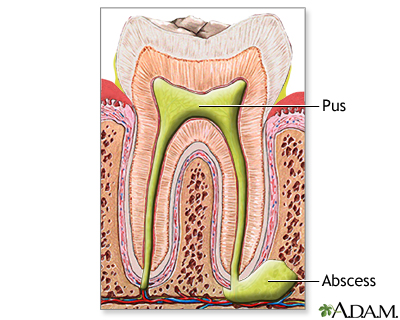Pregnancy SmartSiteTM
Endodontic therapy; Root canal therapy DefinitionA root canal is a dental procedure to save a tooth by removing dead or dying nerve tissue and bacteria from inside a tooth. DescriptionA dentist will use a topical gel and a needle to place numbing medicine (anesthetic) around the bad tooth. You may feel a slight prick when the needle is being inserted. Next, your dentist will use a tiny drill to remove a small portion of the top part of your tooth to expose the pulp. This is typically called gaining access to the pulp. Pulp is made up of nerves, blood vessels, and connective tissue. It is found inside the tooth and runs in tooth canals all the way to the jaw bone. Pulp supplies blood to a tooth and allows you to feel sensations such as temperature. The dead or infected pulp is removed with special tools called files. The canals (tiny pathways inside the tooth) are cleaned and irrigated with disinfecting solution. Medicines may be placed into the area to make sure all the germs are removed and to prevent further infection. Once the tooth is cleaned, canals are filled with a permanent material. The top side of the tooth may be sealed with a soft, temporary material. Once the tooth is filled with a permanent material, a final crown may be placed on top. You may be given antibiotics to treat and prevent infection. Why the Procedure Is PerformedA root canal is done if you have an infection that affects the pulp of a tooth. Generally, there is pain and swelling in the area. The infection can be the result of a tooth crack, cavity, or injury. It may also be the result of a deep pocket in the gum area around a tooth. If this is the case, a dental specialist known as an endodontist should examine the area. Depending on the source of infection and severity of the decay, the tooth may or may not be salvageable. A root canal can save your tooth. Without treatment, the tooth may become so damaged that it must be removed. Root canal must be followed by a permanent restoration. This is done in order to restore the tooth to its original shape and strength so it can withstand the force of chewing. RisksPossible risks of this procedure are:
After the ProcedureYou will need to see your dentist after the procedure to make sure the infection is gone. A dental x-ray will be taken. Regular dental checkups are necessary. For adults, this usually means a visit twice a year. Outlook (Prognosis)You may have some pain or soreness after the procedure. An over-the-counter anti-inflammatory drug, such as ibuprofen, can help relieve discomfort. Most people can return to their normal routine the same day. Until the tooth is permanently filled or covered with a crown, you should avoid rough chewing in the area. ReferencesAmerican Association of Endodontists website. Root canal treatment: What is a root canal? www.aae.org/patients/root-canal-treatment/what-is-a-root-canal/. Accessed June 20, 2024. Nesbit SP, Reside J, Moretti A, et al. The definitive phase of treatment. In: Stefanac SJ, Nesbit SP, eds. Diagnosis and Treatment Planning in Dentistry. 4th ed. St Louis, MO: Elsevier; 2024:chap 11. Renapurkar SK, Abubaker AO. Diagnosis and management of dentoalveolar injuries. In: Fonseca RJ, ed. Oral and Maxillofacial Surgery. 3rd ed. St Louis, MO: Elsevier; 2018:vol 2,chap 6. Setzer F, Chogle S, Torabinejad M. Endodontic treatment outcomes. In: Torabinejad M, Fouad AF, Shabahang S, eds. Endodontics: Principles and Practice. 6th ed. Philadelphia, PA: Elsevier; 2021:chap 22. | ||
| ||
Review Date: 3/31/2024 Reviewed By: Michael Kapner, DDS, General Dentistry, Norwalk Medical Center, Norwalk CT. Review provided by VeriMed Healthcare Network. Also reviewed by David C. Dugdale, MD, Medical Director, Brenda Conaway, Editorial Director, and the A.D.A.M. Editorial team. View References The information provided herein should not be used during any medical emergency or for the diagnosis or treatment of any medical condition. A licensed medical professional should be consulted for diagnosis and treatment of any and all medical conditions. Links to other sites are provided for information only -- they do not constitute endorsements of those other sites. No warranty of any kind, either expressed or implied, is made as to the accuracy, reliability, timeliness, or correctness of any translations made by a third-party service of the information provided herein into any other language. © 1997- A.D.A.M., a business unit of Ebix, Inc. Any duplication or distribution of the information contained herein is strictly prohibited. | ||


 Tooth abscess
Tooth abscess
